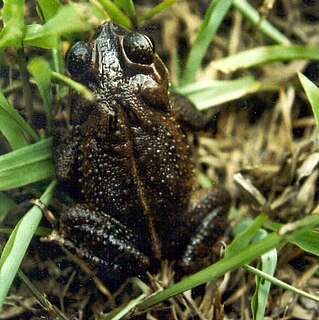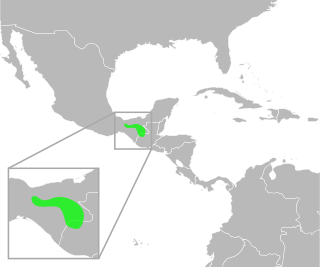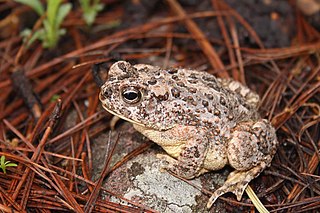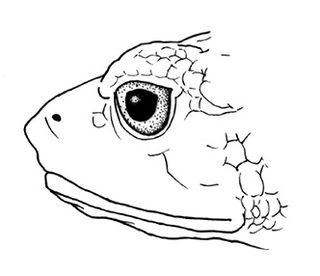The Sumatra toad, Duttaphrynus sumatranus, is a species of toad endemic to Sumatra, Indonesia, and only known from Lubuk Selasi. It has been found along a small, clear stream in secondary forest. It is locally common but listed as a critically endangered species due to a restricted range and continuing habitat loss.

Ansonia hanitschi is a species of toad in the family Bufonidae. It is endemic to mountains of Borneo and found in both Malaysia and Indonesia . Its natural habitats are submontane and montane forests. It inhabits the forest floor. Breeding takes place in clear, rocky mountain streams. It is threatened by habitat loss.

Ansonia muelleri is a species of toad in the family Bufonidae. It is endemic to the Philippines. Its natural habitats are subtropical or tropical dry forests, subtropical or tropical moist lowland forests, subtropical or tropical moist montane forests, rivers, intermittent rivers, and freshwater springs. It is threatened by habitat loss.

Atelopus certus, the Darien stubfoot toad or Toad Mountain harlequin frog, is a species of toad in the family Bufonidae endemic to Panama.
Rhinella amboroensis is a species of toad in the family Bufonidae that is endemic to the region of its type locality in the Carrasco Province of Bolivia and the adjacent Santa Cruz Department. Its common name is Cochabamba toad. It may exist in the Carrasco National Park and/or Amboró National Park, depending on its exact range.
Nannophryne apolobambica is a species of toad in the family Bufonidae. It is endemic to Bolivia and only known from its type locality on the banks of Pelechuco River, Cordillera Apolobamba, in the Franz Tamayo Province of northwestern Bolivia. Its natural habitat is tropical cloud forest. Active toads were found on the forest floor and paths both day and night. It is threatened by habitat loss. The type locality is partly within the Madidi National Park.

Incilius campbelli is a species of toad in the family Bufonidae. It was first described in 1994. It is found in eastern Chiapas (Mexico), Guatemala, western Honduras, and Maya Mountains, Belize. Its natural habitats are lowland moist and premontane wet forests, and pristine forests in mountainous regions. It is threatened by habitat loss.
Nannophryne cophotis, or the Paramo toad, is a species of toad in the family Bufonidae that is endemic to northern Peru. Its natural habitats are puna grassland, high-altitude plateaus, and dry scrubland; it also occurs agricultural land. It breeds in temporary small ponds and permanent shallow streams at altitudes of 2000-4100 meters asl. Individuals have not been recorded since 2005, after what was believed to be a severe decline in its population. It was last known from: Granja Porcón & El Empalme (1999-2000); La Libertad (2003); Ancash (2004); and Cajamarca (2005). If a population exists it is believed to have 0-49 individuals remaining threatened from loss of habitat, pollution, conversion of land for farming, small and large-scale mining concessions, and the modification of waterways.

Incilius macrocristatus a species of toad in the family Bufonidae. It is found in Chiapas in southern Mexico and the adjacent Guatemala. Its natural habitats are cloud forests and pine-oak-Liquidambar forests. Breeding takes place in streams. It is a rare species that is threatened by habitat loss caused by agriculture and human settlement, and by water pollution.

The southwestern toad or Mexican Madre toad is a species of toad in the family Bufonidae. It is endemic to north-western Mexico and found on the Sierra Madre Occidental in eastern Sonora and western Chihuahua and south to south-western Durango. Its natural habitats are conifer forests, commonly along low rivers and streams, its breeding habitat. It is a rare species threatened by habitat disturbance, including alterations causing the desiccation of streams and soils.
Rhinella nesiotes is a species of toad in the family Bufonidae that is endemic to Peru. Its natural habitats are subtropical or tropical moist lowland forests and subtropical or tropical moist montane forests. It is threatened by habitat loss.

Nannophryne variegata, known also as the Eden Harbour toad or Patagonian toad, is a species of toad in the family Bufonidae. It is found in southern Argentina and Chile. There is also a record from Peru, but this requires confirmation given its great geographic and ecological isolation. It occurs in Tierra del Fuego south to 53°S, making it the southernmost amphibian in the world, a record shared with Batrachyla antartandica.
Rhinella vellardi, the Alto Marañon toad, is a species of toad in the family Bufonidae that is endemic to Peru. It is only known from the type locality in the upper Marañón area, Cajamarca Region of northern Peru. Its natural habitat is montane forest in the upper Amazon basin. It is a rare species of which little is known.

The Cannatella's plump toad is a species of toad in the family Bufonidae. It is found in Colombia and Ecuador. Its natural habitats are subtropical or tropical moist montane forests and subtropical or tropical high-altitude shrubland. It is threatened by habitat loss.
The Palawan toadlet or white-striped flathead toad is a species of toad in the family Bufonidae. It is endemic to Palawan, the Philippines.
The Mahenge toad or Loveridge's forest toad, Mertensophryne loveridgei, is a species of toad in the family Bufonidae. It is endemic to Tanzania; its common name refers to the Mahenge Plateau where it can be found. Its natural habitats are tropical forests and woodlands. It is not considered threatened by the IUCN.
Leptobrachium ailaonicum is a species of amphibian in the family Megophryidae. It is found in Yunnan in southern China and on Fansipan mountain in northern Vietnam. Its type locality is Xujiaba in the Ailao Mountains in Jingdong County, Yunnan. At the time of the IUCN assessment in 2004, the population on Fansipan was considered a separate species, Leptobrachium (Vibrissaphora) echinatum, and assessed to be an endangered species.

The Kinabalu horned frog or Balu spadefoot toad is a species of amphibian in the family Megophryidae. It is endemic to northeastern Borneo in Sabah, Malaysia. Its natural habitats are subtropical or tropical moist montane forests and rivers.

The little horned toad, also known as the dwarf horned toad, Kwangshien spadefoot toad, or tiny spadefoot toad, is a species of frog in the family Megophryidae. It is found in southern China, Thailand, Vietnam, and possibly in Laos and Myanmar. It has recently been reported from Bhutan. Its natural habitats are subtropical or tropical moist lowland forests, subtropical or tropical moist montane forests, rivers, and swamps. It is threatened by habitat loss.
Nannophryne is a small genus of true toads, family Bufonidae, from South America. They are found in central Andean Peru south to southern Chile and adjacent Argentina.










